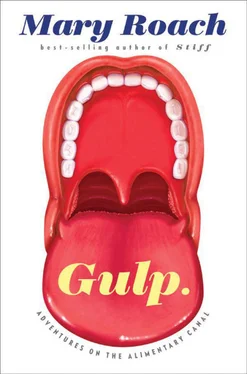Martinez, Anna Paula, and Gisele Regina de Azevedo. “The Bristol Stool Form Scale: Its Translation to Portuguese, Cultural Adaptation, and Validation.” Revista Latino-Americana de Enfermagem 20 (3): 583–589 (May/June 2012).
Offenbacher, S., B. Olsvik, and A. Tonder. “The Similarity of Periodontal Microorganisms between Husband and Wife Cohabitants. Association or Transmission?” Journal of Periodontology 56 (6): 317–323 (June 1985).
Parker-Pope, Tara. “Probiotics: Looking underneath the Yogurt Label.” New York Times (Science Times column “Well”), September 28, 2009.
Silverman, Michael S., Ian Davis, and Dylan R. Pillai. “Success of Self-Administered Home Fecal Transplantation for Chronic Clostridium Difficile Infection.” Clinical Gastroenterology and Hepatology 8 (5): 471–473 (May 2010).
Steenbergen, T. J., et al. “Transmission of Porphyromonas gingivalis between Spouses.” Journal of Clinical Periodontology 20 (5): 340–345 (May 1993).
Terruzzi, Vittorio, et al. “Unsedated Colonoscopy: A Neverending Story.” World Journal of Gastrointestinal Endoscopy 4 (4): 137–141 (April 16, 2012).
Willing, Benjamin P., and Janet K. Jansson. “The Gut Microbiota: Ecology and Function.” In The Fecal Bacteria , edited by M. J. Sadowsky and R. L. Whitman. Washington, D.C.: American Society for Microbiology, 2011.
Packing for Mars: The Curious Science of Life in the Void
Bonk: The Curious Coupling of Science and Sex
Spook: Science Tackles the Afterlife
Stiff: The Curious Lives of Human Cadavers
Copyright © 2013 by Mary Roach
Photograph Credits: Introduction: © SuperStock / SuperStock / Getty Images; Chapter 1: © Bettmann/Corbis; Chapter 2: © Bettmann/Corbis; Chapter 3: © ClassicStock/Corbis; Chapter 4: © Paul Garnier / fStop / Getty Images; Chapter 5: © Bettmann/Corbis; Chapter 6: © CSA Images / Archive / CSA Images / Getty Images; Chapter 7: © Ralph Crane / Time & Life Pictures / Getty Images; Chapter 8: © Fox Photos / Hulton Archive / Getty Images; Chapter 9: © Dennis Kunkel Microscopy, Inc. / Visuals Unlimited / Corbis; Chapter 10: © Bettmann / Corbis; Chapter 11: © Joseph Scherschel / Time & Life Pictures / Getty Images; Chapter 12: © Leemage / Universal Images Group / Getty Images; Chapter 13: © Foodfolio / the food passionates / Corbis; Chapter 14: © Steven Puetzer / The Image Bank / Getty Images; Chapter 15: © Stewart Bremner / Flickr / Getty Images; Chapter 16: © John Wilkes Studio / Corbis; Chapter 17: Netter illustration from www.netterimages.com, used with permission of Elsevier Inc. All rights reserved.
All rights reserved
Printed in the United States of America
First Edition
For information about permission to reproduce selections from this book,
write to Permissions, W. W. Norton & Company, Inc.,
500 Fifth Avenue, New York, NY 10110
For information about special discounts for bulk purchases, please contact
W. W. Norton Special Sales at specialsales@wwnorton.comor 800-233-4830
Manufacturing by Courier Westford
Book design by Judith Stagnitto / Abbate Design
Production manager: Devon Zahn
Library of Congress Cataloging-in-Publication Data
Roach, Mary.
Gulp : adventures on the alimentary canal / Mary Roach.—First edition.
pages cm
Includes bibliographical references.
ISBN 978-0-393-08157-2 (hardcover)
ISBN 978-0-393-24030-6 (e-book)
1. Digestive organs—Popular works. 2. Alimentary canal—Popular works.
3. Gastrointestinal system—Popular works. I. Title.
QP145.R53 2013
612.3—dc23
2012050391
W. W. Norton & Company, Inc.
500 Fifth Avenue, New York, N.Y. 10110
www.wwnorton.com
W. W. Norton & Company Ltd.
Castle House, 75/76 Wells Street, London W1T 3QT
Similar products exist to this day, under names like “Dual Sex Human Torso with Detachable Head” and “Deluxe 16-Part Human Torso,” adding an illicit serial-killer, sex-crime thrill to educational supply catalogues.
In reality, guts are more stew than meat counter, a fact that went underappreciated for centuries. So great was the Victorian taste for order that displaced organs constituted a medical diagnosis. Doctors had been misled not by plastic models, but by cadavers and surgical patients—whose organs ride higher because the body is horizontal. The debut of X-rays, for which patients sit up and guts slosh downward, spawned a fad for surgery on “dropped organs”—hundreds of body parts needlessly hitched up and sewn in place.
The Hair , by Charles Henri Leonard, published in 1879. It was from Leonard that I learned of a framed display of presidential hair, currently residing in the National Museum of American History and featuring snippets from the first fourteen presidents, including a coarse, yellow-gray, “somewhat peculiar” lock from John Quincy Adams. Leonard, himself moderately peculiar, calculated that “a single head of hair of average growth and luxuriousness in any audience of two hundred people will hold supported that entire audience” and, I would add, render an evening at the theater so much the more memorable.
A few words on sniffing. Without it (or a Harley), you miss all but the most potent of smells going on around you. Only 5 to 10 percent of air inhaled while breathing normally reaches the olfactory epithelium, at the roof of the nasal cavity.
Olfaction researchers in need of a controlled, consistently sized sniff use an olfactometer to deliver “odorant pulses.” The technique replaces the rather more vigorous “blast olfactometry” as well as the original olfactometer, which connected to a glass and aluminum box called the “camera inodorata.” (“The subject’s head was placed in the box,” wrote the inventor, alarmingly, in 1921.)
An Internet search on the medical term for nostrils produced this: “Save on Nasal Nares! Free 2-day Shipping with Amazon Prime.” They really are taking over the world.
“Skunky” is between “rotten egg” and “canned corn” on the Defects Wheel for Beer. (Langstaff designed diagnostic wheels for off-flavors in wine, beer, and olive oil.) In the absence of skunks, a mild rendition of skunkiness is achieved by oxidating beer, that is, exposing it to air, as by spilling it or leaving out half-filled glasses.
In 2010, inventor George Eapen and snack-food giant Frito-Lay took the comparison beyond the realm of metaphor. They patented a system whereby snack-food bags could be printed with a bar code allowing consumers to retrieve and download a fifteen-second audio clip of a symphonic interlude, with the different instruments representing the various flavor components. Eapen, in his patent, used the example of a salsa-flavored corn chip. “A piano intro begins upon the customer’s perception of the cilantro flavoring…. The full band section occurs at approximately the time that the consumer perceives the tomatillo and lime flavors…. A second melody section corresponds to the sensation of the heat burn imparted by the Serrano chili.” U.S. Patent No. 7,942,311 includes sheet music for the salsa-flavored chip experience.
It could be worse. In 1984, goat-milk flavor panelists were enlisted by a team of Pennsylvania ag researchers to sleuth the source of a nasty “goaty” flavor that intermittently fouls goat milk. The main suspect was a noxious odor from the scent glands of amorous male goats. But there was also this: “The buck in rut sprays urine over its chin and neck area.” Five pungent compounds isolated from the urine and scent glands of rutting males were added, one at a time, to samples of pure, sweet goat milk. The panelists rated each sample for “goaty” “rancid,” and “musky-melon” flavors. Simple answers proved elusive. “A thorough investigation of ‘goaty’ flavor,” the researchers concluded, “is beyond the scope of this paper.”
Читать дальше












